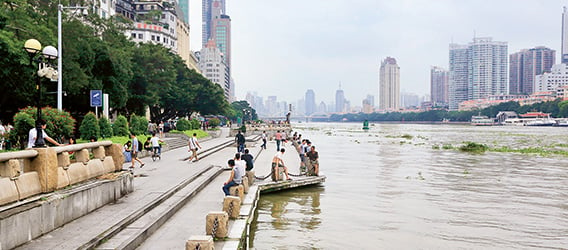The mighty city
New Yorkers are proud — and rightly so — of their cityʼs distinctiveness and prominence. At Swiss Re we are proud to work in public-private partnership to enhance the resilience of the great city.
But as a concentration of people and assets, New York is only becoming more common. In less than twenty years the list of ʼmegacitiesʼ like New York — meaning cities with more than 10 million inhabitants — will grow by more than half, from 23 to 37. Nearly all of the worldʼs population growth over this period will take place in cities (both large and small). By 2050 75% of the worldʼs population is expected to live in cities. Swiss Re is at the forefront of understanding and preparing for an urban future.
Urbanisation — insured
As detailed in our October 2013 sigma study, China and India are on the crest of the urbanisation wave. China will account for 20% of the increase in the global urban population through 2030, and India for 16%. In regional terms, Asia and Africa will experience the greatest rates of urban population growth.

People gather along the banks of the Pearl River in Guangzhou, Guangdong Province, China.
The growth of cities worldwide means increasing wealth, more industrial production and a larger workforce. All of this means growth for insurance.
SHARE
OF THE WORLDʼS POPULATION
75%
LIVING IN CITIES BY 2050
The development of urban-industrial clusters will drive demand for commercial insurance. Rising levels of income and asset ownership drive strong growth in motor and homeowner insurance — a trend already well underway.
Urban lifestyles lead to more ʼurbanʼ diseases such as cardiovascular illness and lung cancer. The risk of transmission of communicable diseases is also greater in cities, where dense urban environments can give rise to pandemics. All these factors will drive growth in health insurance.
Cities concentrate not only people, but wealth. Urbanisation leads to enormous concentrations of property values. Given low insurance penetration in many of those markets, a natural disaster can expose a massive gap between economic losses and what insurance will cover.
Swiss Re is eager to meet the urban challenge head-on. Primarily we do this by helping insurers manage their capital and risk exposure. We also work directly with public authorities in cities like New York and Miami (see Reaching new shores and Living up to our corporate responsibility).
Networking for resilience
Urban resilience is a challenge that concerns us all, and so we are reaching outside of our usual networks to advance the cause. In 2013 we joined the Rockefeller Foundation to lead the 100 Resilient Cities Centennial Challenge. The Challenge will support at least 100 cities in hiring a Chief Resilience Officer and creating a resilience strategy.
“River floods could affect 380 million people living in cities today, while some 280 million people could be impacted by severe earthquakes.”
Matthias Weber
Group Chief Underwriting Officer, Swiss Re
The aim is to strengthen citiesʼ ability to prepare for and bounce back more quickly from natural disasters, pandemics or even terrorism. Successful interventions will save lives and protect property, speed up recovery and lessen the impact on public and private budgets.
We aim to offer participating cities access to innovative finance to fund their resilience strategies. Through the Challenge we also look forward to bringing our expertise to the aid of Chief Resilience Officers, supporting the development of the Chief Resilience Officer network and contributing our own risk management insights and tools.

Asia will lead urban growth in the decades ahead.
Applied expertise
One of those tools is CatNet®. At a glance it seems simple — hazard information laid over Google Maps™. CatNet® is highly visual and easy to understand.
But itʼs more than just an online atlas of natural hazards. The tool distils years of historical data — the same data that underpins our natural catastrophe underwriting. CatNet® is an ideal tool to transfer our in-house expertise not only to Chief Resilience Officers, but to stimulate dialogue and debate on urban resilience among the public at large.
Our 2013 publication “Mind the Risk” used CatNet® to identify and quantify the natural catastrophe risk facing 616 urban areas globally in human and economic terms. The report covers 1.7 billion people and about USD 34 trillion in economic value — or approximately a quarter of the global population and half of the gross world product. As the report found and 2013 loss figures would attest, flooding puts more people in danger than any other natural peril. The cities most exposed to natural catastrophes (in both human and economic terms) are located in Asia — the region that will also account for the lionʼs share of urban growth in the decades ahead.
The time is now
Our work in understanding the intersection of urbanisation, resilience and risk is protecting lives and assets today. This summer CatNet® was critical in supporting our insurance partners working in flood-affected towns and cities in Canada and Central Europe. They could see the extent of the flood damage and anticipate incoming claims on a real-time basis. Once the storms passed, it became all the clearer what affected cities should do to mitigate the impact of flooding in the future.
We look forward to establishing that same level of engagement with the worldʼs cities as they grow and thrive.
Further reading:
More on our commitment to urban resilience on swissre.com/rethinking